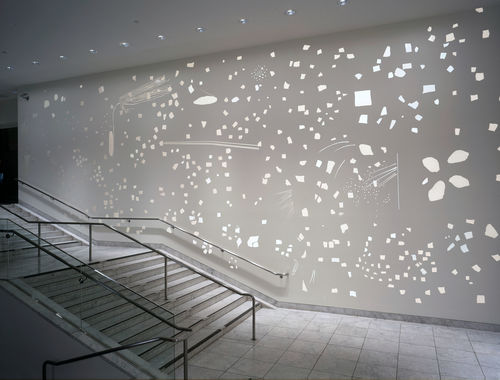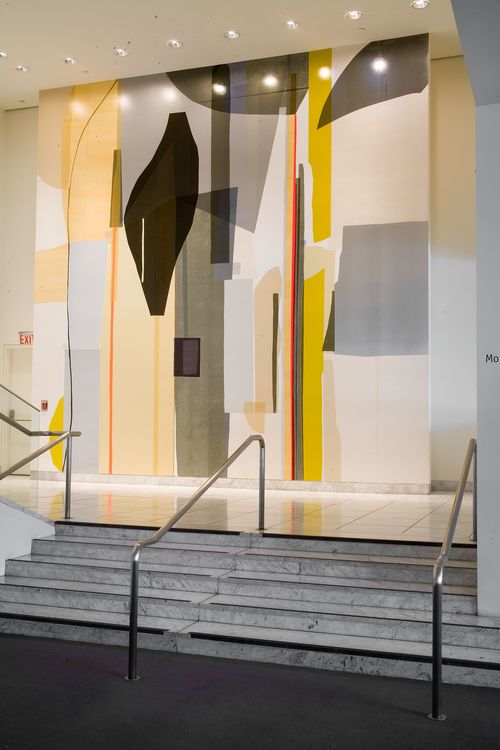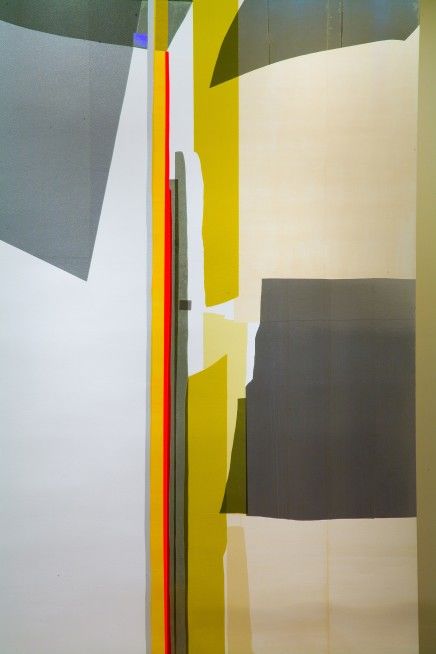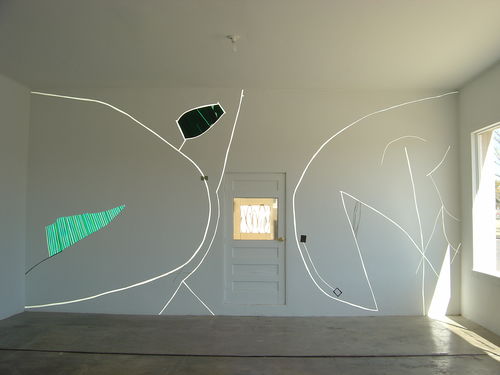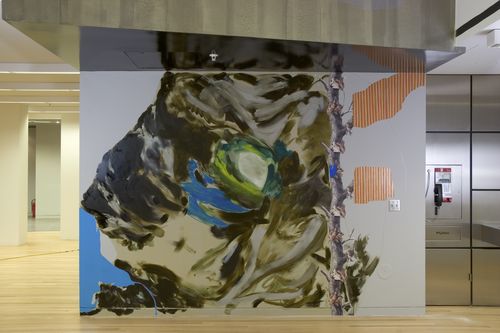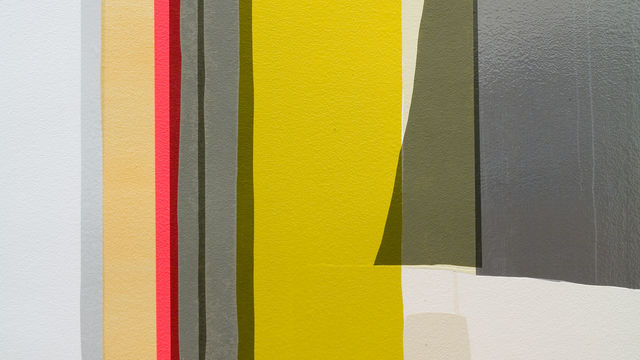
Hammer Projects: Monique van Genderen
- – This is a past exhibition
Monique van Genderen creates large-scale wall paintings that make use of adhesive vinyl with various reflective, translucent, and matte finishes. Solid architectural surfaces are transformed into changeable spaces through the play of light on the materials, which shift, disappear, and reappear as one passes by. Inspired by the tradition of abstract painting as well as contemporary graphic design and computer generated patterns, van Genderen's work challenges the expectations of painting.
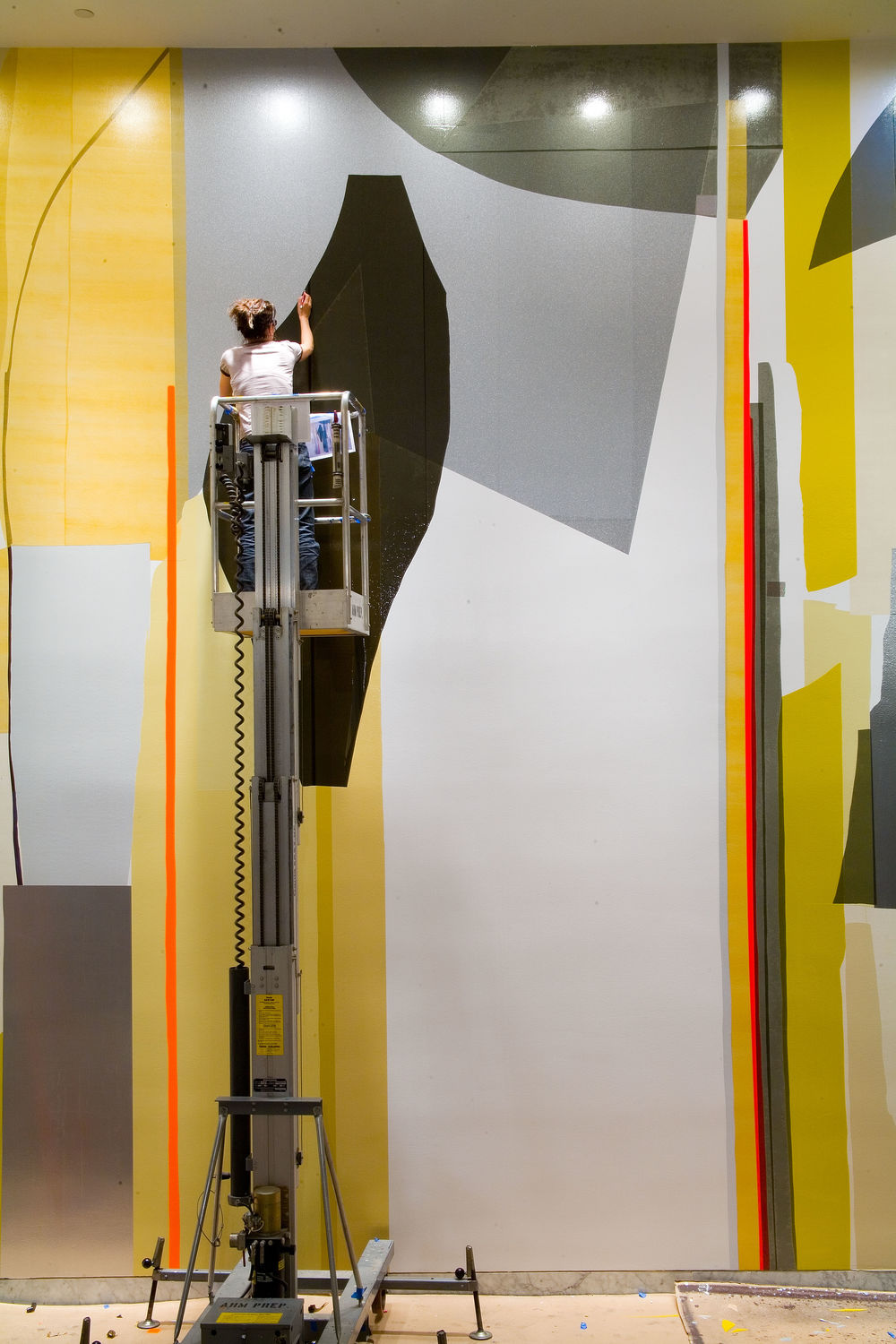
Biography
Monique van Genderen was born in 1965 in Vancouver, British Columbia, and lives in Los Angeles. She received her BFA in 1987 from the University of California, San Diego, and her MFA in 1991 from California Institute of the Arts, Valencia. Solo exhibitions of her work have been organized at Bernier/Eliades Gallery, Athens; the Wexner Center for the Arts, Columbus, Ohio; the Happy Lion Gallery, Los Angeles; and the Pennsylvania Academy of the Fine Arts, Philadelphia. Her work has also been included in group exhibitions at the New Museum, New York; the Weatherspoon Museum of Art, Greensboro, North Carolina; and in the 48th Corcoran Biennial in Washington, D.C. In 2004 van Genderen was awarded a Chinati Foundation artist's residency.
Essay
By Jane McFadden
The paintings that first established Monique van Genderen’s reputation were not made with paint, and this is the first in a series of slippages that her work engenders. Constructed from torn and collaged vinyl, her early works make reference to a history of high modernist abstraction, even as their materials are remnants from her job as a maker of commercial signs. Some of these signs are produced for the walls of local galleries to announce their exhibitions, and the gallery wall also becomes a ground for van Genderen’s own practice. In this layering of signification, from wall to sign to paint and back again, the artist engages the structures of the art world without becoming mired in mere conceptual asides. In recent years, she has expanded her range of materials to include enamel and watercolor, among others, and the slippages continue—between one material and another, between work and context, between one visual moment and the next.
A recent exhibition, My Watercolor Story (2005), included three panels in which van Genderen transforms the hard-edge enamel of sign paint into a variety of visual surfaces. In “...beyond the breakaway point...” (2005), gray enamel produces a murky depth through a wash of brush strokes that is reminiscent of watercolor. In The Bather (2005) distinct layers of blue and green produce a play of light and shadow that mimics her vinyl collages. Each work maintains its abstract nature, yet the materials themselves take on a representational quality—one thing for another. Layers of enamel refer to watercolor like layers of vinyl refer to paint. To be able to accept a material moment as both one thing and another—to see and hold two contrary possibilities in mind—is a key experience of van Genderen’s work. While this experience begins in the visual, it resonates out into the contexts of her practice. My Watercolor Story also contained a long singular walnut shelf onto which van Genderen placed bound volumes of delicate watercolors, page after page. The clean lines and muted tones of the volumes and shelf disguise the generative, temporal, sketchlike quality of the watercolors inside. The shelf in turn suggests a contemporary interest in the intersection of design and art, the industrial and the handmade. Functional and sculptural, it requires that the viewer think of both simultaneously, like vinyl and paint.
Van Genderen graduated from California Institute of the Arts in the early 1990s, and although she may be associated with other Los Angeles painters of that decade, her work engages a complex vocabulary of historical and contemporary references. The use of intense color and industrial materials in her work reflects a Southern California finish fetish that began to surface, along with a variety of technologically enhanced colors, in the 1960s. The intense saturation that her materials provide is complemented by the dynamic nature of light and reflection that they engender, and the resultant visual tensions between the material and immaterial echo the long-standing importance of light and space in the region as well. Van Genderen plays with her Southern Californian history, moving between the high stakes of abstraction and the culture of sun and sand. Appropriately, she describes her often freehand process of installation as “surfing the walls.” The metaphor not only suggests how a variety of materials and contexts become active in her painting process but also proposes an experience for the viewer. The wandering nature of the paint in space and the play of veneer, reflection, and light make the walls of her installations, and an experience of them, dynamic. A storefront installation in Marfa,Texas, in 2004 to conclude her residency at the Chinati Foundation even welcomed the “drive-by” viewer. The Hammer Museum installation promises a similar audience with its well-known window onto one of the busiest intersections in Los Angeles, as it also engages the origins of the fetish for finish—the flash of sunlight on cars.
Van Genderen’s Hammer installation contains three distinct elements that reveal the diversity of her practice and resist easy categorization of her work. One piece, stemming from a “very vinyl oriented” 2001 sketch, poses a subtle correction to any sense that her recent use of actual paint may be distanced from its vinyl origins.1 A second reflective installation was designed by van Genderen with those driving by in mind, yet in order to resist becoming spectacle, it leaves the white wall apparent. A third element—a panel installed at the top of the stairs—moves beyond the usual context of lobby installations at the Hammer. The panel is one of a series of black panels that van Genderen has made since 2004. Dominated by a dark, dense, black ground, it produces a visual depth as well as a reflective surface in which the viewer may appear. The resultant slippage between figure, ground, and context serves as a metaphor for the engaged form of viewing that the visual and conceptual complexities of the installation require.
Van Genderen’s materials raise questions about abstract painting and its relation to everything else, and installation is key to this investigation. By engaging the physical framework of her art, she draws attention to the intertwined relationship between painting and its contexts, both institutional and historical. If Clement Greenberg once set the stakes for American modernist abstraction by arguing that painting should be a play among pigment, surface, and support, van Genderen riffs on this possibility, not only by cutting supports to fit certain contexts or by collaging vinyl as paint, but also at times, by literally gluing the canvas to the wall. This physical and visual relationship between work and frame also acknowledges that the history of abstract painting is one of its institutional discourses. Van Genderen’s work brings to mind pivotal moments in the history of art in which both the wall and the institution became the focus of aesthetic and critical consideration, and certainly installation was key to the development of her Californian contemporaries. Van Genderen cites an additional genealogy for her practice, that of Felix Gonzalez-Torres, an instructor at CalArts during her tenure there, whose subtle yet charged politics challenged the roles of the institution and the audience. The reference resonates well, for situated within each instance of tension in van Genderen’s work, between the perceived confines of abstract painting and the world outside the frame, is the question of the politics of art itself. Her practice encourages a viewer who can follow these inquiries through the pleasure of surfing the walls.
Notes
1. All quotations from the artist are from a recent conversation with the author.
Jane McFadden is a historian of modern and contemporary art whose work focuses on the interdisciplinary practices of the 1960s. She is the associate chair of liberal arts and sciences and director of graduate studies in criticism and theory at Art Center College of Design in Pasadena.
Hammer Projects are made possible with support from The Horace W. Goldsmith Foundation, the Annenberg Foundation, Fox Entertainment Group's Arts Development Fee, the Los Angeles County Arts Commission, and members of the Hammer Circle.




